results were considered along with that, before each test samples were sonicated for 20 minutes. Results shown in Table-1 indicates that material-1 is having lowest wear scar diameter compare to material-2 and 3 with respect to the base oil. As shown in Figure-1 TEM images were taken at 2µm using FEI Tecnai 20 transmission electron microscope (TEM). In addition, image processing shows that Material-1 has highest number of layers, material-2 has moderate and material-3 has least.

Figure-1 TEM images of three forms of rGO
To analyze the effect of these additives on lubricant’s key properties, kinematic viscosity and viscosity index were measured as per ASTM D445 and ASTM D2270. Results shown in Fig-2 indicates that there is no enormous difference in the viscosity and viscosity index on the materials having additives in comparison with the base oil (control sample) which proves that because of these additives lubricant will not sacrifice temperature resistive characteristic.

Figure 2 - Kinematic viscosity
CONCLUSION:As three forms of rGO were prepared using modified hummer’s method and tested at 0.05%w/w concentration, which showed excellent effect on reducing steel-steel direct contact and uphold wear properties of the material without affecting lubricant’s key property. Out of all three forms of rGO, material-1 having least density and more number of particles helps to improve the sustainability and wear ability of the mating parts. The findings in this project can direct to new generation of lubricant enhanced by graphene-based nanomaterials. For future study, friction coefficient can be investigated with respect to time, load and speed; also higher concentration of additives can be checked.
REFERENCES:
[1] W. J. a. H. L. a. K. P. Evans, "Thermal conductivity of graphene ribbons from equilibrium molecular dynamics: Effect of ribbon width, edge roughness, and hydrogen termination," Applied Physics Letters, vol. 96, p. 203112, 2010.
[2] R. S. R. Sungjin Park, "Chemical methods for the production of graphenes," Nature Nanotechnology, vol. 4, pp. 217-224, 2009.